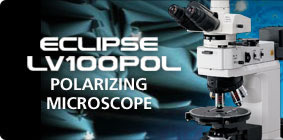Nikon Eclipse LV100 POL Polarizing Microscope
Nikon Updated: 2007-06-19Accomplishes advanced polarizing microscopy under both diascopic and episcopic illumination.
Nikon's Eclipse polarizing microscopes are renowned for their abilitiy to produce brighter, clearer, and higher contrast images. The LV100 POL, available in diascopic and episcopic illumination types, continues this tradition and offers a completely reengineered base for even easier operation. It also features an exclusive high-intensity halogen light source, which delivers brighter images, lower power consumption and less heat generation, thereby reducing the chance of heat-induced focus drift.
Vibration Resistant Stage
The large sized circular stage is supported near the optical axis and incorporates steal cross roller guides making the stage twice as stable and durable as conventional models. The stage is also extremely accurate, centerable to the optical axis, and provides click-stops at 45° increments.
Diascopic (Transmitted) Light Source
The new high intensity 50W halogen light source incorporates a fly-eye lens design that outputs more light than a 100W lamp. The greater brightness is achieved by optimizing the lamp filament size and optically expanding the size of the light source within the pupil illumination fulfillment.
Lead and Arsenic Free Objective Lenses
The new CFI LU Plan Fluor EPI P objective series uses eco-glass that is manufactured to the same specifications as Nikon's proprietary infinity optics (CFI60) system, but without harmful substances such as lead and arsenic.
30mm Focusing Stroke
The focus stoke has been improved to 30mm, facilitating observation of tall samples.
Reversed Centering Nosepiece
Up to five objectives, ranging from 4x to100x can be mounted to the nosepiece and all five objectives are centerable. The nosepiece is also provided with a DIN compliant compensator slot and it accepts various compensators for advanced quantitative measurements.
Bertrand Lens Incorporated into Design of Intermediate Tube
The Bertrand lens enables both the observation and capture of conoscopic and orthoscopic images. The Bertrand lens is also focusable and centerable.
Rotatable Slider Type Analyzer
The high precision slider-type analyzer located in the intermediate tube is rotatable for a full 360°.
Reduced Focus Drift
Focus drift resulting from light source heat is greatly reduced by virtue of the lower power consumption and heat generated from the new diascopic light source.
Diascopic and Episcopic Polarization
Both Diascopic (transmitted) and Episcopic (reflected) polarization observations are possible by mounting the LV-UEPI universal epi-illuminator. The epi-illuminator system uses the same fly-eye lens design as the new diascopic light source.
Episcopic DIC (Differential Interference Contrast)
By mounting the LV-UEPI universal epi-illuminator and optional universal-type nosepiece and DIC accessories including objectives, Episcopic DIC microscopy is possible.
High-Precision Rotating Stage
The stage is large-sized, pre-adjusted and click-stops in 45° increments, making it extremely accurate and easy to rotate. Because the stage is designed to be supported from the bottom of the microscope near the optical axis and incorporates steel cross roller guides, it is twice as stable and durable as conventional stages.
LV100 POL/Eclipse 50i POL
Related Manuals
Nikon Eclipse 50i POL Polarizing Microscope
Nikon SMZ645/660 Zoom Stereomicroscope
Nikon SMZ800 Zoom Stereomicroscope
Nikon Eclipse E200 POL Polarizing Microscope
Nikon SMZ1000 Zoom Stereomicroscope
Nikon SMZ1500 Zoom Stereomicroscope
Nikon LiveScan SFC Swept Field Confocal Microscope
Nikon Eclipse C1 Plus Confocal Microscope System
Nikon Eclipse C1si Confocal Microscope System
Nikon MM400/800 Industrial Measuring Microscopes
Nikon NWL-641 IC Inspection Wafer Loader
Nikon NWL-860 IC Inspection Wafer Loader
